Competitive Strategy Analysis: Target Market & Global Branding
VerifiedAdded on 2019/10/30
|12
|2759
|246
Report
AI Summary
This report provides a comprehensive analysis of the competitive strategies employed by Apple, Mercedes, Samsung, and Tesla. It delves into how these companies have successfully targeted specific markets, selected appropriate entry modes, and established strong global brands. The report examines Apple's focus on premium customers and licensing strategies, Mercedes' market segmentation and Greenfield approach, Samsung's hybrid branding and product positioning, and Tesla's product dominance and corporate branding. The analysis highlights the importance of understanding consumer behavior, creating product differentiation, and leveraging brand image to achieve a competitive edge in the global market. The report concludes by summarizing the key strategies each company uses to gain and maintain their market positions, offering valuable insights into effective business development practices. This report, contributed by a student, can be found on Desklib, a platform offering AI-based study tools for students.
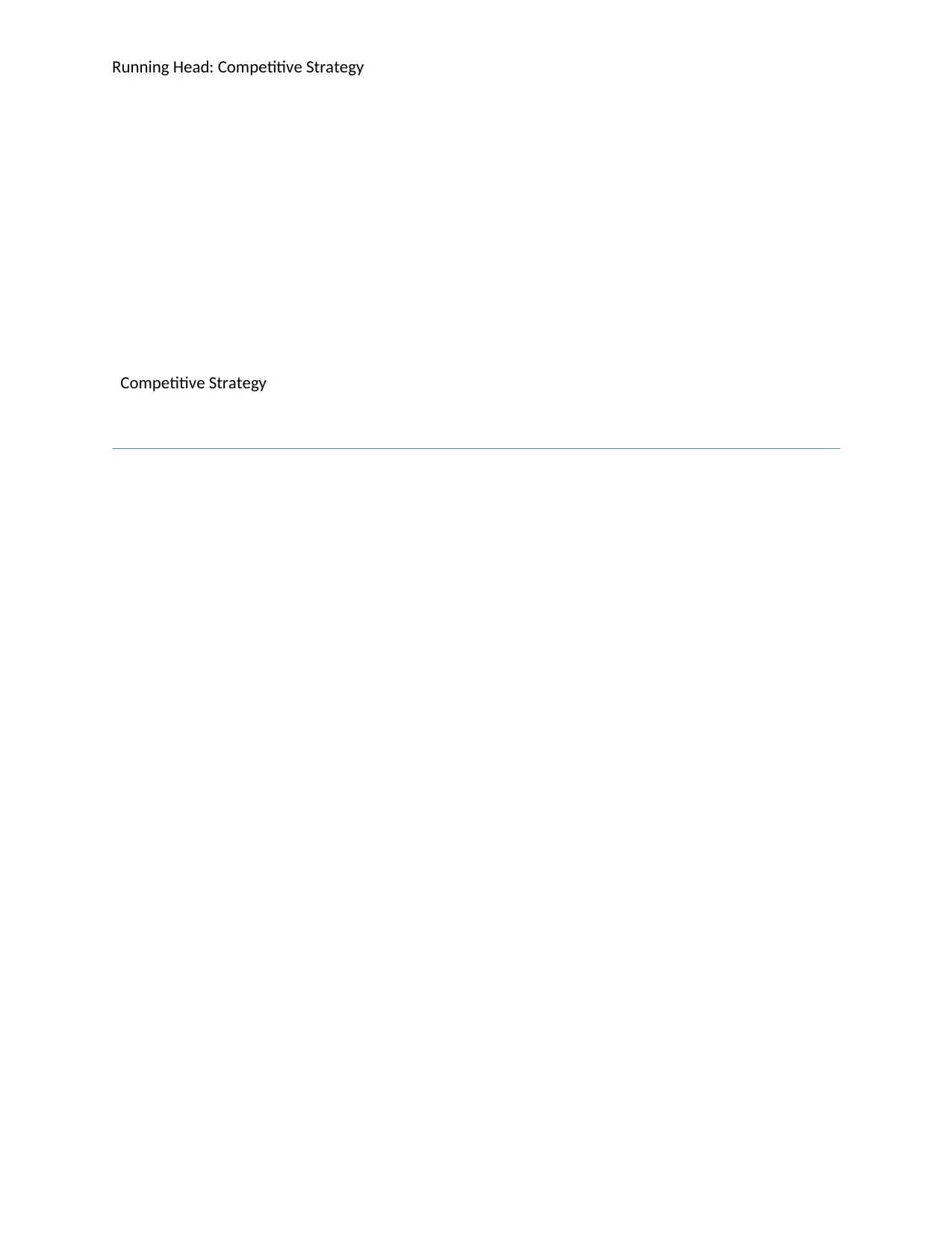
Running Head: Competitive Strategy
Competitive Strategy
Competitive Strategy
Paraphrase This Document
Need a fresh take? Get an instant paraphrase of this document with our AI Paraphraser
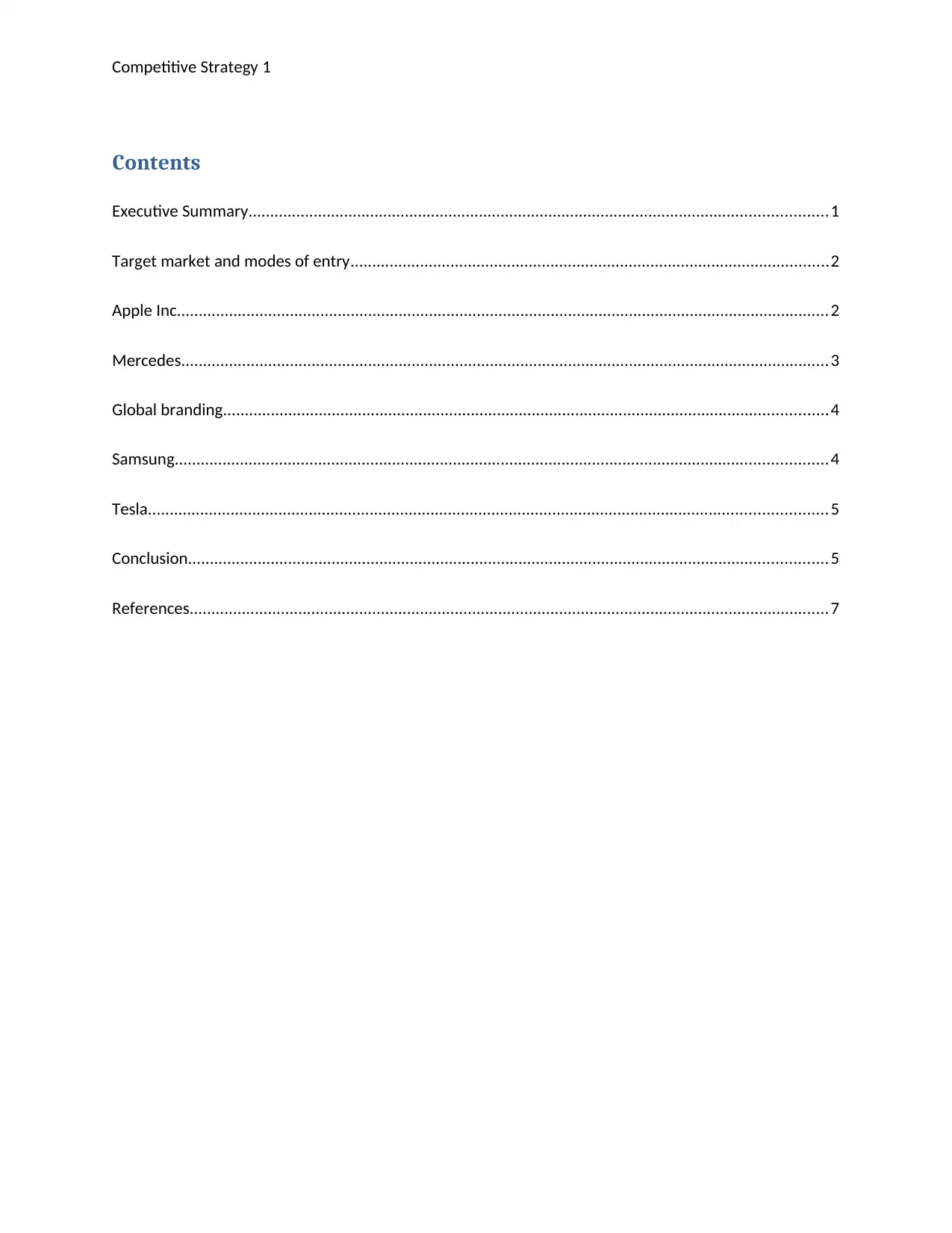
Competitive Strategy 1
Contents
Executive Summary.....................................................................................................................................1
Target market and modes of entry..............................................................................................................2
Apple Inc......................................................................................................................................................2
Mercedes.....................................................................................................................................................3
Global branding...........................................................................................................................................4
Samsung......................................................................................................................................................4
Tesla............................................................................................................................................................5
Conclusion...................................................................................................................................................5
References...................................................................................................................................................7
Contents
Executive Summary.....................................................................................................................................1
Target market and modes of entry..............................................................................................................2
Apple Inc......................................................................................................................................................2
Mercedes.....................................................................................................................................................3
Global branding...........................................................................................................................................4
Samsung......................................................................................................................................................4
Tesla............................................................................................................................................................5
Conclusion...................................................................................................................................................5
References...................................................................................................................................................7
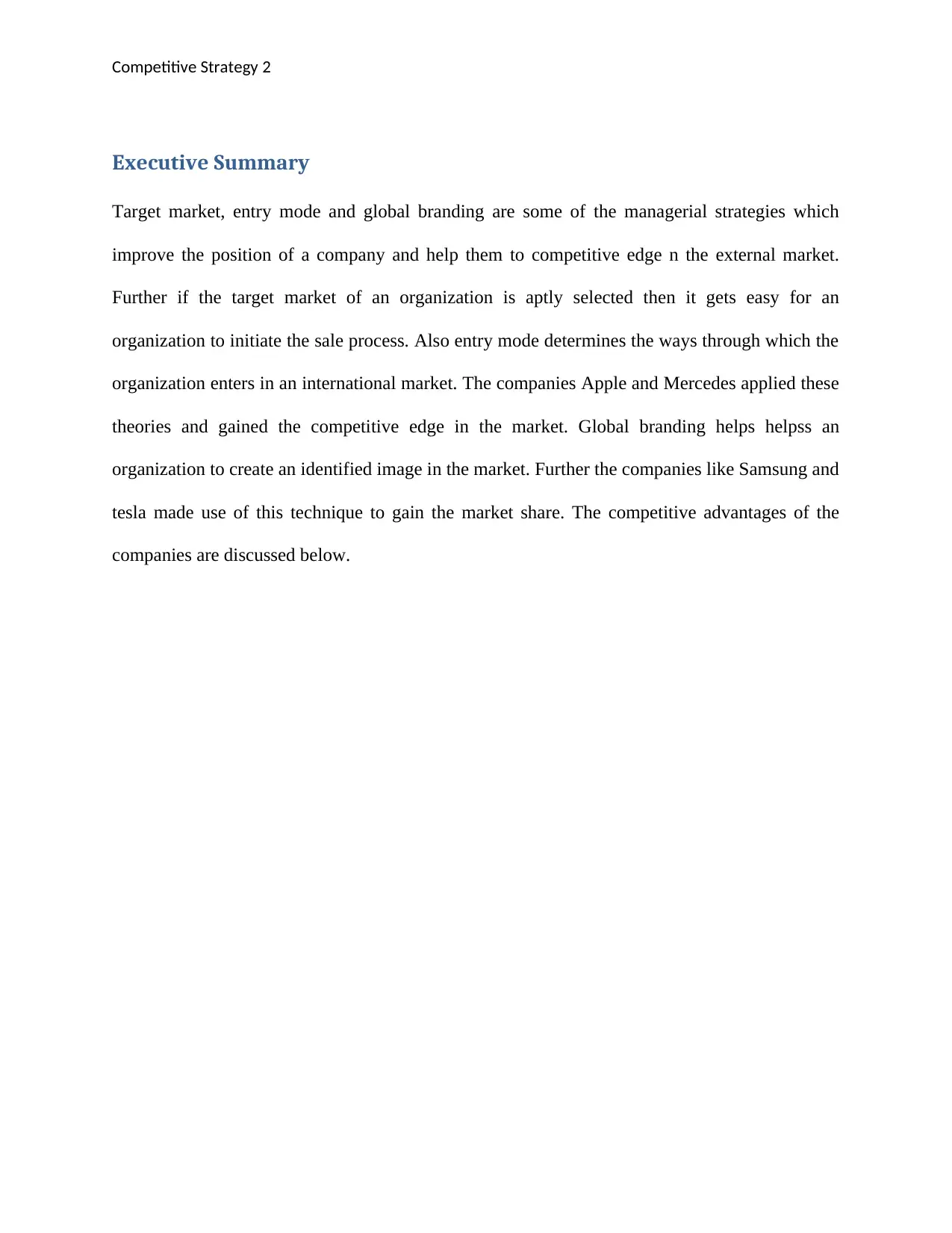
Competitive Strategy 2
Executive Summary
Target market, entry mode and global branding are some of the managerial strategies which
improve the position of a company and help them to competitive edge n the external market.
Further if the target market of an organization is aptly selected then it gets easy for an
organization to initiate the sale process. Also entry mode determines the ways through which the
organization enters in an international market. The companies Apple and Mercedes applied these
theories and gained the competitive edge in the market. Global branding helps helpss an
organization to create an identified image in the market. Further the companies like Samsung and
tesla made use of this technique to gain the market share. The competitive advantages of the
companies are discussed below.
Executive Summary
Target market, entry mode and global branding are some of the managerial strategies which
improve the position of a company and help them to competitive edge n the external market.
Further if the target market of an organization is aptly selected then it gets easy for an
organization to initiate the sale process. Also entry mode determines the ways through which the
organization enters in an international market. The companies Apple and Mercedes applied these
theories and gained the competitive edge in the market. Global branding helps helpss an
organization to create an identified image in the market. Further the companies like Samsung and
tesla made use of this technique to gain the market share. The competitive advantages of the
companies are discussed below.
⊘ This is a preview!⊘
Do you want full access?
Subscribe today to unlock all pages.

Trusted by 1+ million students worldwide
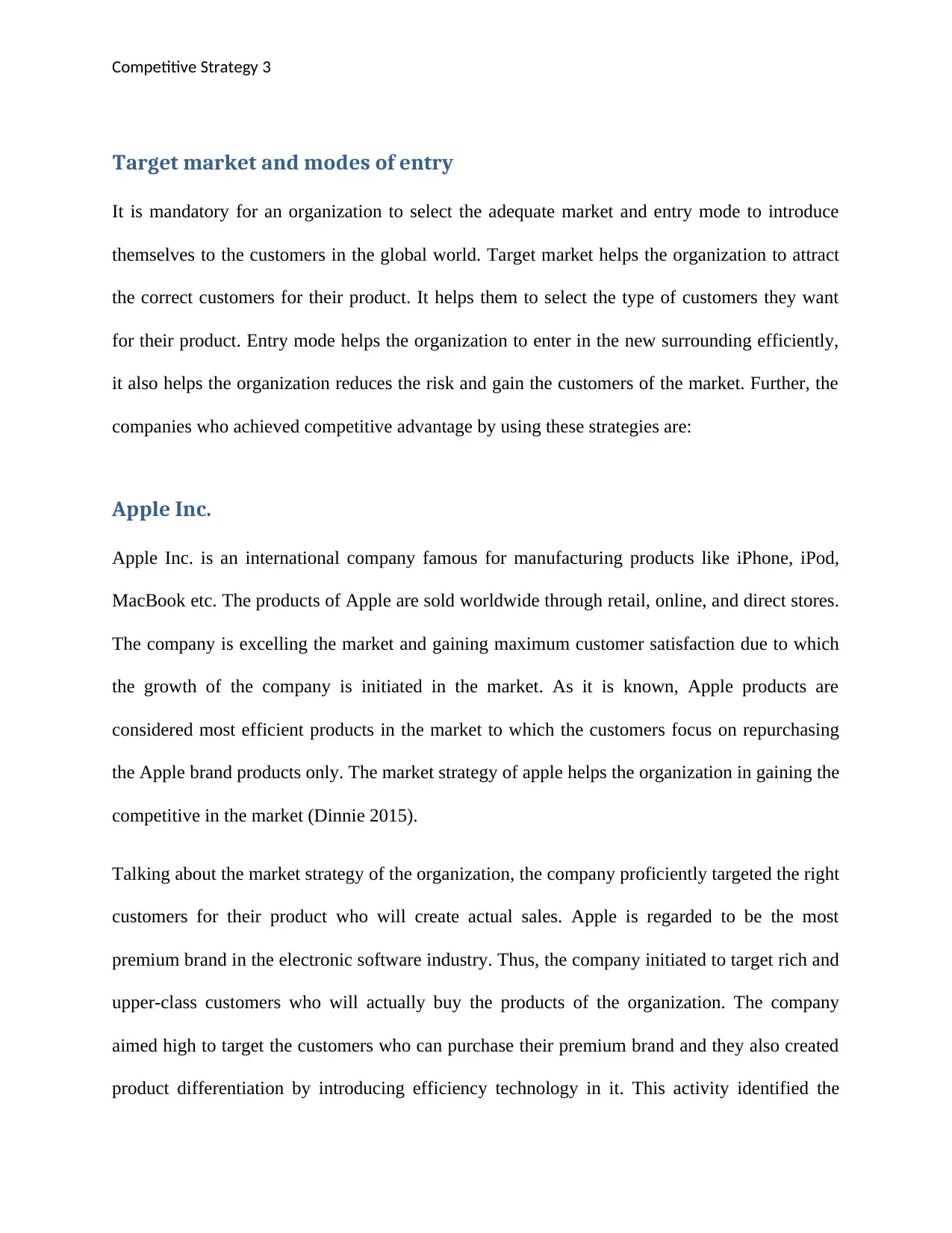
Competitive Strategy 3
Target market and modes of entry
It is mandatory for an organization to select the adequate market and entry mode to introduce
themselves to the customers in the global world. Target market helps the organization to attract
the correct customers for their product. It helps them to select the type of customers they want
for their product. Entry mode helps the organization to enter in the new surrounding efficiently,
it also helps the organization reduces the risk and gain the customers of the market. Further, the
companies who achieved competitive advantage by using these strategies are:
Apple Inc.
Apple Inc. is an international company famous for manufacturing products like iPhone, iPod,
MacBook etc. The products of Apple are sold worldwide through retail, online, and direct stores.
The company is excelling the market and gaining maximum customer satisfaction due to which
the growth of the company is initiated in the market. As it is known, Apple products are
considered most efficient products in the market to which the customers focus on repurchasing
the Apple brand products only. The market strategy of apple helps the organization in gaining the
competitive in the market (Dinnie 2015).
Talking about the market strategy of the organization, the company proficiently targeted the right
customers for their product who will create actual sales. Apple is regarded to be the most
premium brand in the electronic software industry. Thus, the company initiated to target rich and
upper-class customers who will actually buy the products of the organization. The company
aimed high to target the customers who can purchase their premium brand and they also created
product differentiation by introducing efficiency technology in it. This activity identified the
Target market and modes of entry
It is mandatory for an organization to select the adequate market and entry mode to introduce
themselves to the customers in the global world. Target market helps the organization to attract
the correct customers for their product. It helps them to select the type of customers they want
for their product. Entry mode helps the organization to enter in the new surrounding efficiently,
it also helps the organization reduces the risk and gain the customers of the market. Further, the
companies who achieved competitive advantage by using these strategies are:
Apple Inc.
Apple Inc. is an international company famous for manufacturing products like iPhone, iPod,
MacBook etc. The products of Apple are sold worldwide through retail, online, and direct stores.
The company is excelling the market and gaining maximum customer satisfaction due to which
the growth of the company is initiated in the market. As it is known, Apple products are
considered most efficient products in the market to which the customers focus on repurchasing
the Apple brand products only. The market strategy of apple helps the organization in gaining the
competitive in the market (Dinnie 2015).
Talking about the market strategy of the organization, the company proficiently targeted the right
customers for their product who will create actual sales. Apple is regarded to be the most
premium brand in the electronic software industry. Thus, the company initiated to target rich and
upper-class customers who will actually buy the products of the organization. The company
aimed high to target the customers who can purchase their premium brand and they also created
product differentiation by introducing efficiency technology in it. This activity identified the
Paraphrase This Document
Need a fresh take? Get an instant paraphrase of this document with our AI Paraphraser
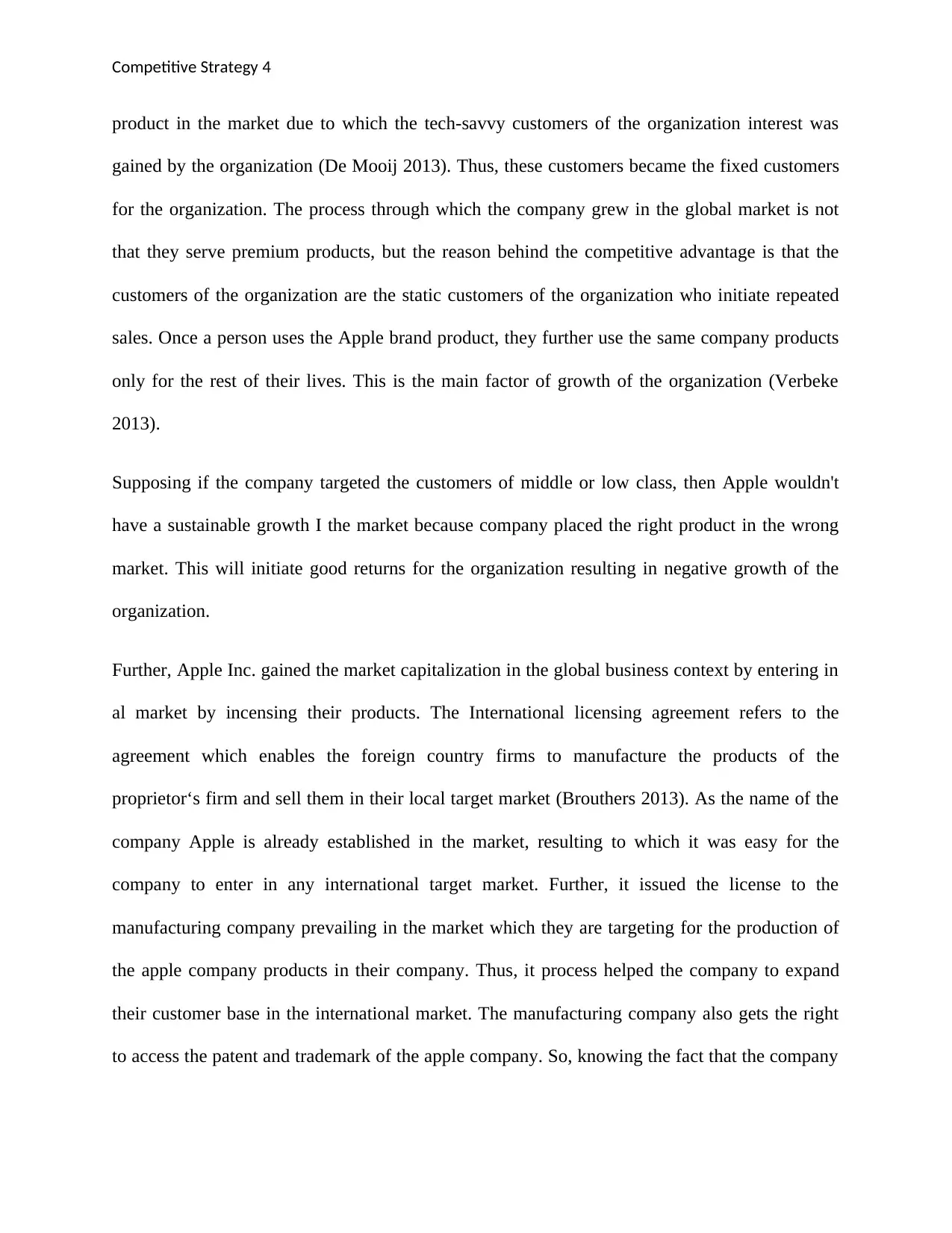
Competitive Strategy 4
product in the market due to which the tech-savvy customers of the organization interest was
gained by the organization (De Mooij 2013). Thus, these customers became the fixed customers
for the organization. The process through which the company grew in the global market is not
that they serve premium products, but the reason behind the competitive advantage is that the
customers of the organization are the static customers of the organization who initiate repeated
sales. Once a person uses the Apple brand product, they further use the same company products
only for the rest of their lives. This is the main factor of growth of the organization (Verbeke
2013).
Supposing if the company targeted the customers of middle or low class, then Apple wouldn't
have a sustainable growth I the market because company placed the right product in the wrong
market. This will initiate good returns for the organization resulting in negative growth of the
organization.
Further, Apple Inc. gained the market capitalization in the global business context by entering in
al market by incensing their products. The International licensing agreement refers to the
agreement which enables the foreign country firms to manufacture the products of the
proprietor‘s firm and sell them in their local target market (Brouthers 2013). As the name of the
company Apple is already established in the market, resulting to which it was easy for the
company to enter in any international target market. Further, it issued the license to the
manufacturing company prevailing in the market which they are targeting for the production of
the apple company products in their company. Thus, it process helped the company to expand
their customer base in the international market. The manufacturing company also gets the right
to access the patent and trademark of the apple company. So, knowing the fact that the company
product in the market due to which the tech-savvy customers of the organization interest was
gained by the organization (De Mooij 2013). Thus, these customers became the fixed customers
for the organization. The process through which the company grew in the global market is not
that they serve premium products, but the reason behind the competitive advantage is that the
customers of the organization are the static customers of the organization who initiate repeated
sales. Once a person uses the Apple brand product, they further use the same company products
only for the rest of their lives. This is the main factor of growth of the organization (Verbeke
2013).
Supposing if the company targeted the customers of middle or low class, then Apple wouldn't
have a sustainable growth I the market because company placed the right product in the wrong
market. This will initiate good returns for the organization resulting in negative growth of the
organization.
Further, Apple Inc. gained the market capitalization in the global business context by entering in
al market by incensing their products. The International licensing agreement refers to the
agreement which enables the foreign country firms to manufacture the products of the
proprietor‘s firm and sell them in their local target market (Brouthers 2013). As the name of the
company Apple is already established in the market, resulting to which it was easy for the
company to enter in any international target market. Further, it issued the license to the
manufacturing company prevailing in the market which they are targeting for the production of
the apple company products in their company. Thus, it process helped the company to expand
their customer base in the international market. The manufacturing company also gets the right
to access the patent and trademark of the apple company. So, knowing the fact that the company
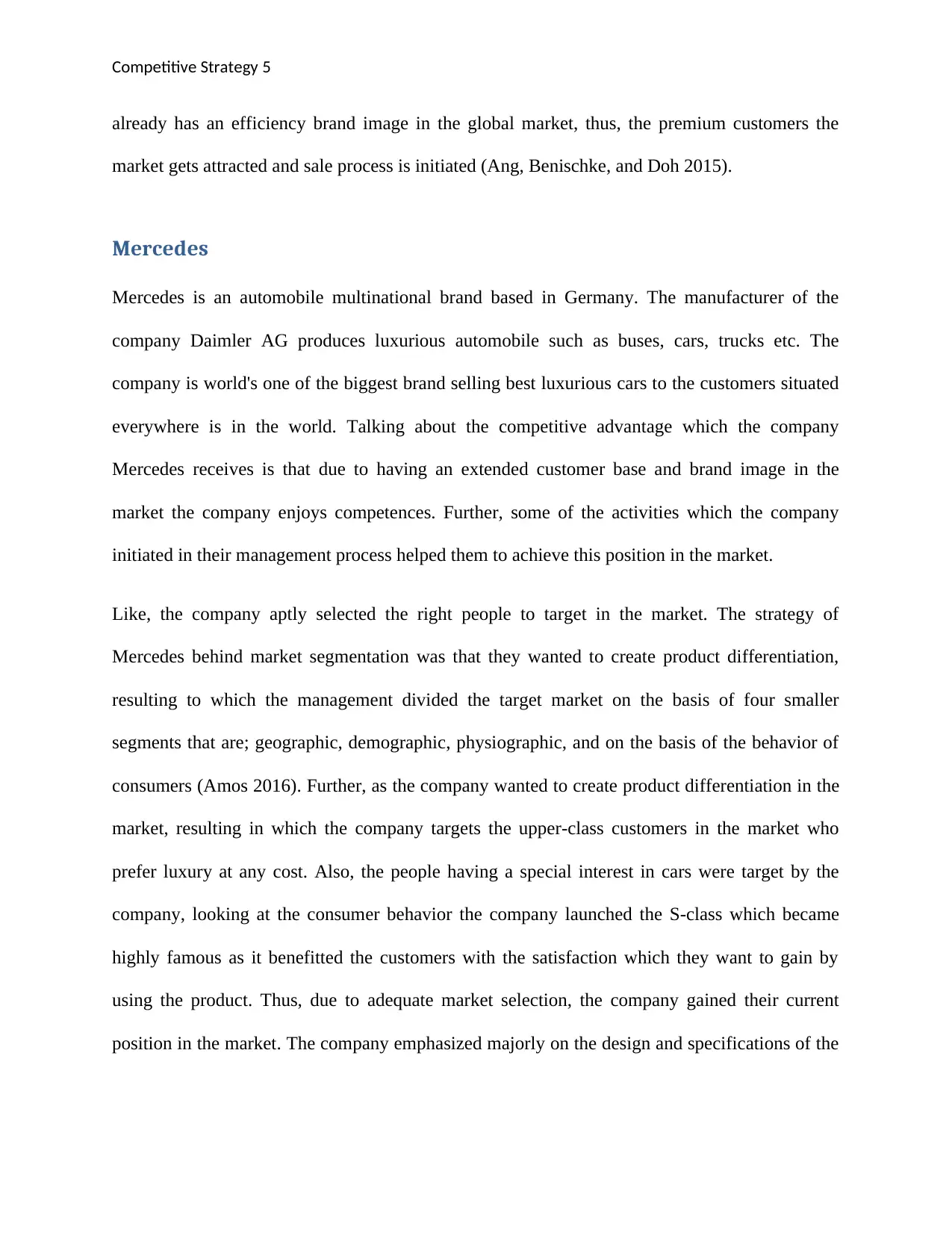
Competitive Strategy 5
already has an efficiency brand image in the global market, thus, the premium customers the
market gets attracted and sale process is initiated (Ang, Benischke, and Doh 2015).
Mercedes
Mercedes is an automobile multinational brand based in Germany. The manufacturer of the
company Daimler AG produces luxurious automobile such as buses, cars, trucks etc. The
company is world's one of the biggest brand selling best luxurious cars to the customers situated
everywhere is in the world. Talking about the competitive advantage which the company
Mercedes receives is that due to having an extended customer base and brand image in the
market the company enjoys competences. Further, some of the activities which the company
initiated in their management process helped them to achieve this position in the market.
Like, the company aptly selected the right people to target in the market. The strategy of
Mercedes behind market segmentation was that they wanted to create product differentiation,
resulting to which the management divided the target market on the basis of four smaller
segments that are; geographic, demographic, physiographic, and on the basis of the behavior of
consumers (Amos 2016). Further, as the company wanted to create product differentiation in the
market, resulting in which the company targets the upper-class customers in the market who
prefer luxury at any cost. Also, the people having a special interest in cars were target by the
company, looking at the consumer behavior the company launched the S-class which became
highly famous as it benefitted the customers with the satisfaction which they want to gain by
using the product. Thus, due to adequate market selection, the company gained their current
position in the market. The company emphasized majorly on the design and specifications of the
already has an efficiency brand image in the global market, thus, the premium customers the
market gets attracted and sale process is initiated (Ang, Benischke, and Doh 2015).
Mercedes
Mercedes is an automobile multinational brand based in Germany. The manufacturer of the
company Daimler AG produces luxurious automobile such as buses, cars, trucks etc. The
company is world's one of the biggest brand selling best luxurious cars to the customers situated
everywhere is in the world. Talking about the competitive advantage which the company
Mercedes receives is that due to having an extended customer base and brand image in the
market the company enjoys competences. Further, some of the activities which the company
initiated in their management process helped them to achieve this position in the market.
Like, the company aptly selected the right people to target in the market. The strategy of
Mercedes behind market segmentation was that they wanted to create product differentiation,
resulting to which the management divided the target market on the basis of four smaller
segments that are; geographic, demographic, physiographic, and on the basis of the behavior of
consumers (Amos 2016). Further, as the company wanted to create product differentiation in the
market, resulting in which the company targets the upper-class customers in the market who
prefer luxury at any cost. Also, the people having a special interest in cars were target by the
company, looking at the consumer behavior the company launched the S-class which became
highly famous as it benefitted the customers with the satisfaction which they want to gain by
using the product. Thus, due to adequate market selection, the company gained their current
position in the market. The company emphasized majorly on the design and specifications of the
⊘ This is a preview!⊘
Do you want full access?
Subscribe today to unlock all pages.

Trusted by 1+ million students worldwide
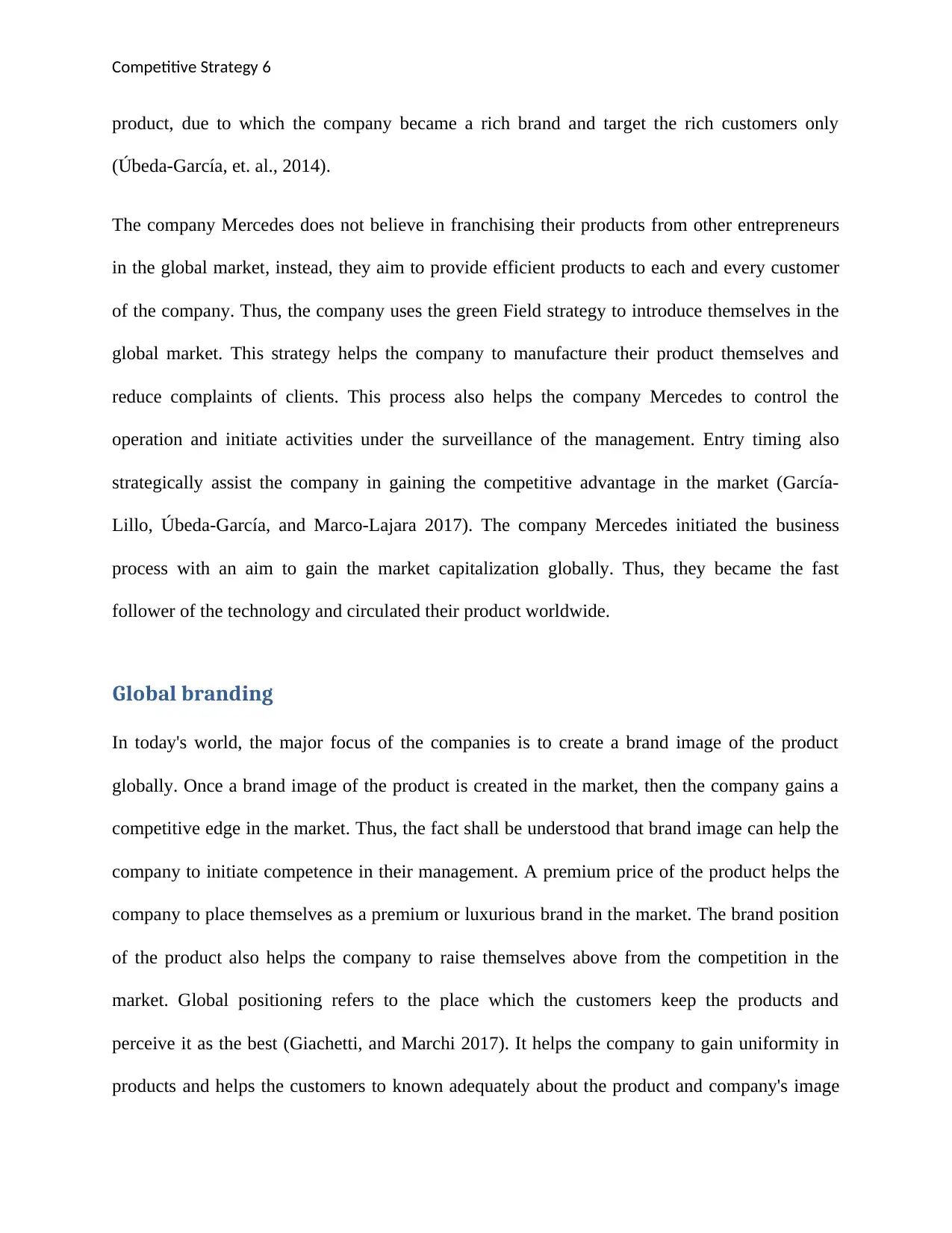
Competitive Strategy 6
product, due to which the company became a rich brand and target the rich customers only
(Úbeda-García, et. al., 2014).
The company Mercedes does not believe in franchising their products from other entrepreneurs
in the global market, instead, they aim to provide efficient products to each and every customer
of the company. Thus, the company uses the green Field strategy to introduce themselves in the
global market. This strategy helps the company to manufacture their product themselves and
reduce complaints of clients. This process also helps the company Mercedes to control the
operation and initiate activities under the surveillance of the management. Entry timing also
strategically assist the company in gaining the competitive advantage in the market (García-
Lillo, Úbeda-García, and Marco-Lajara 2017). The company Mercedes initiated the business
process with an aim to gain the market capitalization globally. Thus, they became the fast
follower of the technology and circulated their product worldwide.
Global branding
In today's world, the major focus of the companies is to create a brand image of the product
globally. Once a brand image of the product is created in the market, then the company gains a
competitive edge in the market. Thus, the fact shall be understood that brand image can help the
company to initiate competence in their management. A premium price of the product helps the
company to place themselves as a premium or luxurious brand in the market. The brand position
of the product also helps the company to raise themselves above from the competition in the
market. Global positioning refers to the place which the customers keep the products and
perceive it as the best (Giachetti, and Marchi 2017). It helps the company to gain uniformity in
products and helps the customers to known adequately about the product and company's image
product, due to which the company became a rich brand and target the rich customers only
(Úbeda-García, et. al., 2014).
The company Mercedes does not believe in franchising their products from other entrepreneurs
in the global market, instead, they aim to provide efficient products to each and every customer
of the company. Thus, the company uses the green Field strategy to introduce themselves in the
global market. This strategy helps the company to manufacture their product themselves and
reduce complaints of clients. This process also helps the company Mercedes to control the
operation and initiate activities under the surveillance of the management. Entry timing also
strategically assist the company in gaining the competitive advantage in the market (García-
Lillo, Úbeda-García, and Marco-Lajara 2017). The company Mercedes initiated the business
process with an aim to gain the market capitalization globally. Thus, they became the fast
follower of the technology and circulated their product worldwide.
Global branding
In today's world, the major focus of the companies is to create a brand image of the product
globally. Once a brand image of the product is created in the market, then the company gains a
competitive edge in the market. Thus, the fact shall be understood that brand image can help the
company to initiate competence in their management. A premium price of the product helps the
company to place themselves as a premium or luxurious brand in the market. The brand position
of the product also helps the company to raise themselves above from the competition in the
market. Global positioning refers to the place which the customers keep the products and
perceive it as the best (Giachetti, and Marchi 2017). It helps the company to gain uniformity in
products and helps the customers to known adequately about the product and company's image
Paraphrase This Document
Need a fresh take? Get an instant paraphrase of this document with our AI Paraphraser
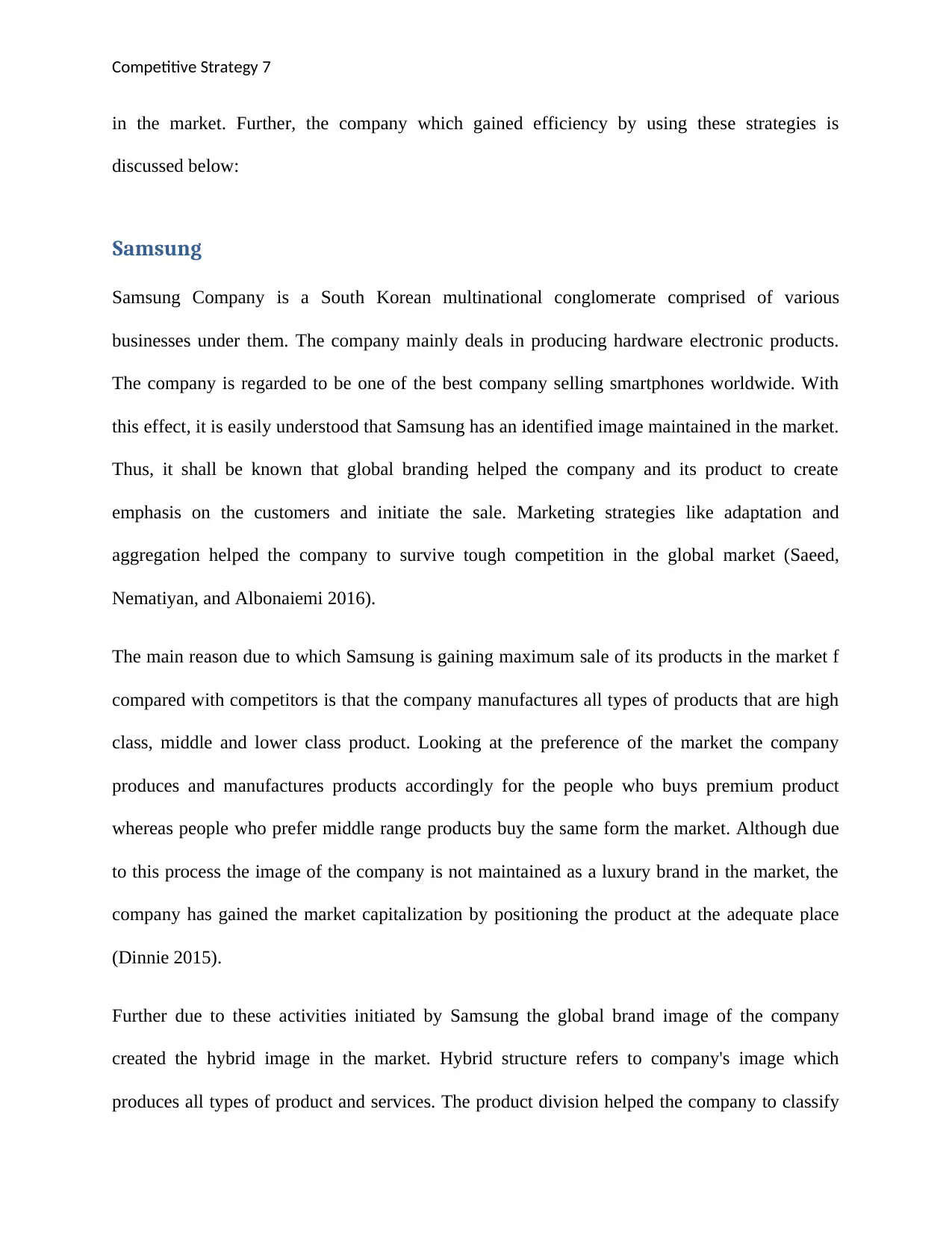
Competitive Strategy 7
in the market. Further, the company which gained efficiency by using these strategies is
discussed below:
Samsung
Samsung Company is a South Korean multinational conglomerate comprised of various
businesses under them. The company mainly deals in producing hardware electronic products.
The company is regarded to be one of the best company selling smartphones worldwide. With
this effect, it is easily understood that Samsung has an identified image maintained in the market.
Thus, it shall be known that global branding helped the company and its product to create
emphasis on the customers and initiate the sale. Marketing strategies like adaptation and
aggregation helped the company to survive tough competition in the global market (Saeed,
Nematiyan, and Albonaiemi 2016).
The main reason due to which Samsung is gaining maximum sale of its products in the market f
compared with competitors is that the company manufactures all types of products that are high
class, middle and lower class product. Looking at the preference of the market the company
produces and manufactures products accordingly for the people who buys premium product
whereas people who prefer middle range products buy the same form the market. Although due
to this process the image of the company is not maintained as a luxury brand in the market, the
company has gained the market capitalization by positioning the product at the adequate place
(Dinnie 2015).
Further due to these activities initiated by Samsung the global brand image of the company
created the hybrid image in the market. Hybrid structure refers to company's image which
produces all types of product and services. The product division helped the company to classify
in the market. Further, the company which gained efficiency by using these strategies is
discussed below:
Samsung
Samsung Company is a South Korean multinational conglomerate comprised of various
businesses under them. The company mainly deals in producing hardware electronic products.
The company is regarded to be one of the best company selling smartphones worldwide. With
this effect, it is easily understood that Samsung has an identified image maintained in the market.
Thus, it shall be known that global branding helped the company and its product to create
emphasis on the customers and initiate the sale. Marketing strategies like adaptation and
aggregation helped the company to survive tough competition in the global market (Saeed,
Nematiyan, and Albonaiemi 2016).
The main reason due to which Samsung is gaining maximum sale of its products in the market f
compared with competitors is that the company manufactures all types of products that are high
class, middle and lower class product. Looking at the preference of the market the company
produces and manufactures products accordingly for the people who buys premium product
whereas people who prefer middle range products buy the same form the market. Although due
to this process the image of the company is not maintained as a luxury brand in the market, the
company has gained the market capitalization by positioning the product at the adequate place
(Dinnie 2015).
Further due to these activities initiated by Samsung the global brand image of the company
created the hybrid image in the market. Hybrid structure refers to company's image which
produces all types of product and services. The product division helped the company to classify
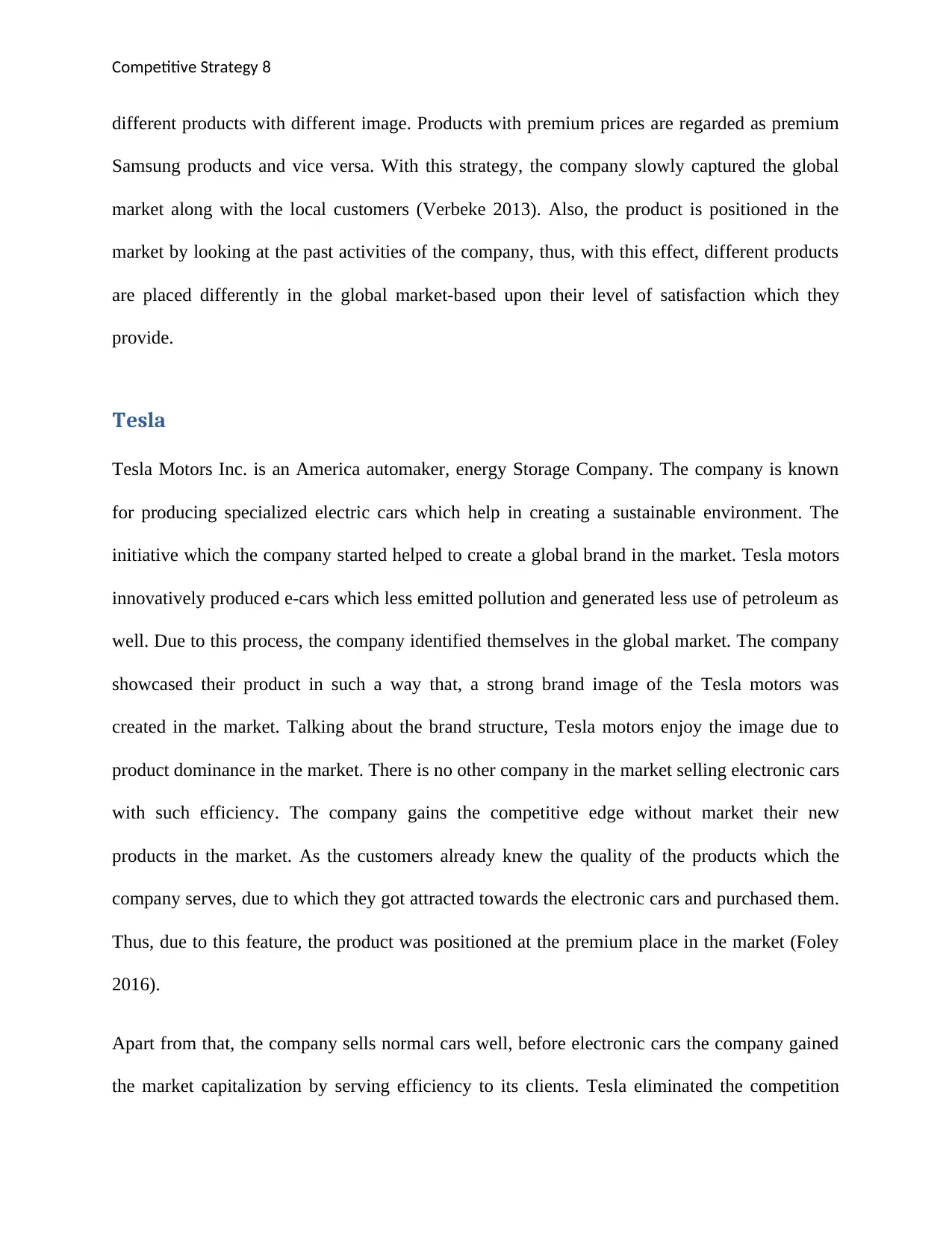
Competitive Strategy 8
different products with different image. Products with premium prices are regarded as premium
Samsung products and vice versa. With this strategy, the company slowly captured the global
market along with the local customers (Verbeke 2013). Also, the product is positioned in the
market by looking at the past activities of the company, thus, with this effect, different products
are placed differently in the global market-based upon their level of satisfaction which they
provide.
Tesla
Tesla Motors Inc. is an America automaker, energy Storage Company. The company is known
for producing specialized electric cars which help in creating a sustainable environment. The
initiative which the company started helped to create a global brand in the market. Tesla motors
innovatively produced e-cars which less emitted pollution and generated less use of petroleum as
well. Due to this process, the company identified themselves in the global market. The company
showcased their product in such a way that, a strong brand image of the Tesla motors was
created in the market. Talking about the brand structure, Tesla motors enjoy the image due to
product dominance in the market. There is no other company in the market selling electronic cars
with such efficiency. The company gains the competitive edge without market their new
products in the market. As the customers already knew the quality of the products which the
company serves, due to which they got attracted towards the electronic cars and purchased them.
Thus, due to this feature, the product was positioned at the premium place in the market (Foley
2016).
Apart from that, the company sells normal cars well, before electronic cars the company gained
the market capitalization by serving efficiency to its clients. Tesla eliminated the competition
different products with different image. Products with premium prices are regarded as premium
Samsung products and vice versa. With this strategy, the company slowly captured the global
market along with the local customers (Verbeke 2013). Also, the product is positioned in the
market by looking at the past activities of the company, thus, with this effect, different products
are placed differently in the global market-based upon their level of satisfaction which they
provide.
Tesla
Tesla Motors Inc. is an America automaker, energy Storage Company. The company is known
for producing specialized electric cars which help in creating a sustainable environment. The
initiative which the company started helped to create a global brand in the market. Tesla motors
innovatively produced e-cars which less emitted pollution and generated less use of petroleum as
well. Due to this process, the company identified themselves in the global market. The company
showcased their product in such a way that, a strong brand image of the Tesla motors was
created in the market. Talking about the brand structure, Tesla motors enjoy the image due to
product dominance in the market. There is no other company in the market selling electronic cars
with such efficiency. The company gains the competitive edge without market their new
products in the market. As the customers already knew the quality of the products which the
company serves, due to which they got attracted towards the electronic cars and purchased them.
Thus, due to this feature, the product was positioned at the premium place in the market (Foley
2016).
Apart from that, the company sells normal cars well, before electronic cars the company gained
the market capitalization by serving efficiency to its clients. Tesla eliminated the competition
⊘ This is a preview!⊘
Do you want full access?
Subscribe today to unlock all pages.

Trusted by 1+ million students worldwide
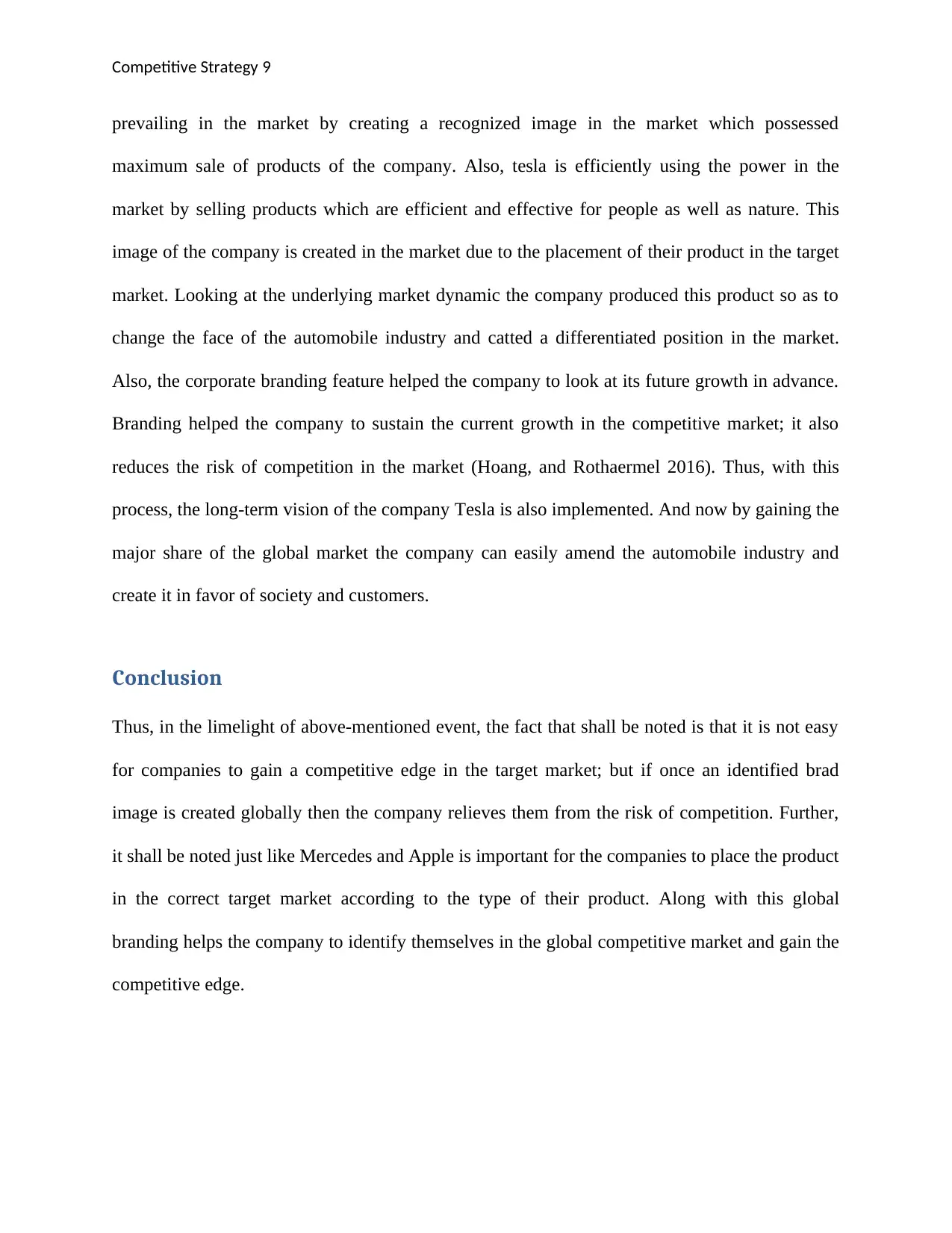
Competitive Strategy 9
prevailing in the market by creating a recognized image in the market which possessed
maximum sale of products of the company. Also, tesla is efficiently using the power in the
market by selling products which are efficient and effective for people as well as nature. This
image of the company is created in the market due to the placement of their product in the target
market. Looking at the underlying market dynamic the company produced this product so as to
change the face of the automobile industry and catted a differentiated position in the market.
Also, the corporate branding feature helped the company to look at its future growth in advance.
Branding helped the company to sustain the current growth in the competitive market; it also
reduces the risk of competition in the market (Hoang, and Rothaermel 2016). Thus, with this
process, the long-term vision of the company Tesla is also implemented. And now by gaining the
major share of the global market the company can easily amend the automobile industry and
create it in favor of society and customers.
Conclusion
Thus, in the limelight of above-mentioned event, the fact that shall be noted is that it is not easy
for companies to gain a competitive edge in the target market; but if once an identified brad
image is created globally then the company relieves them from the risk of competition. Further,
it shall be noted just like Mercedes and Apple is important for the companies to place the product
in the correct target market according to the type of their product. Along with this global
branding helps the company to identify themselves in the global competitive market and gain the
competitive edge.
prevailing in the market by creating a recognized image in the market which possessed
maximum sale of products of the company. Also, tesla is efficiently using the power in the
market by selling products which are efficient and effective for people as well as nature. This
image of the company is created in the market due to the placement of their product in the target
market. Looking at the underlying market dynamic the company produced this product so as to
change the face of the automobile industry and catted a differentiated position in the market.
Also, the corporate branding feature helped the company to look at its future growth in advance.
Branding helped the company to sustain the current growth in the competitive market; it also
reduces the risk of competition in the market (Hoang, and Rothaermel 2016). Thus, with this
process, the long-term vision of the company Tesla is also implemented. And now by gaining the
major share of the global market the company can easily amend the automobile industry and
create it in favor of society and customers.
Conclusion
Thus, in the limelight of above-mentioned event, the fact that shall be noted is that it is not easy
for companies to gain a competitive edge in the target market; but if once an identified brad
image is created globally then the company relieves them from the risk of competition. Further,
it shall be noted just like Mercedes and Apple is important for the companies to place the product
in the correct target market according to the type of their product. Along with this global
branding helps the company to identify themselves in the global competitive market and gain the
competitive edge.
Paraphrase This Document
Need a fresh take? Get an instant paraphrase of this document with our AI Paraphraser
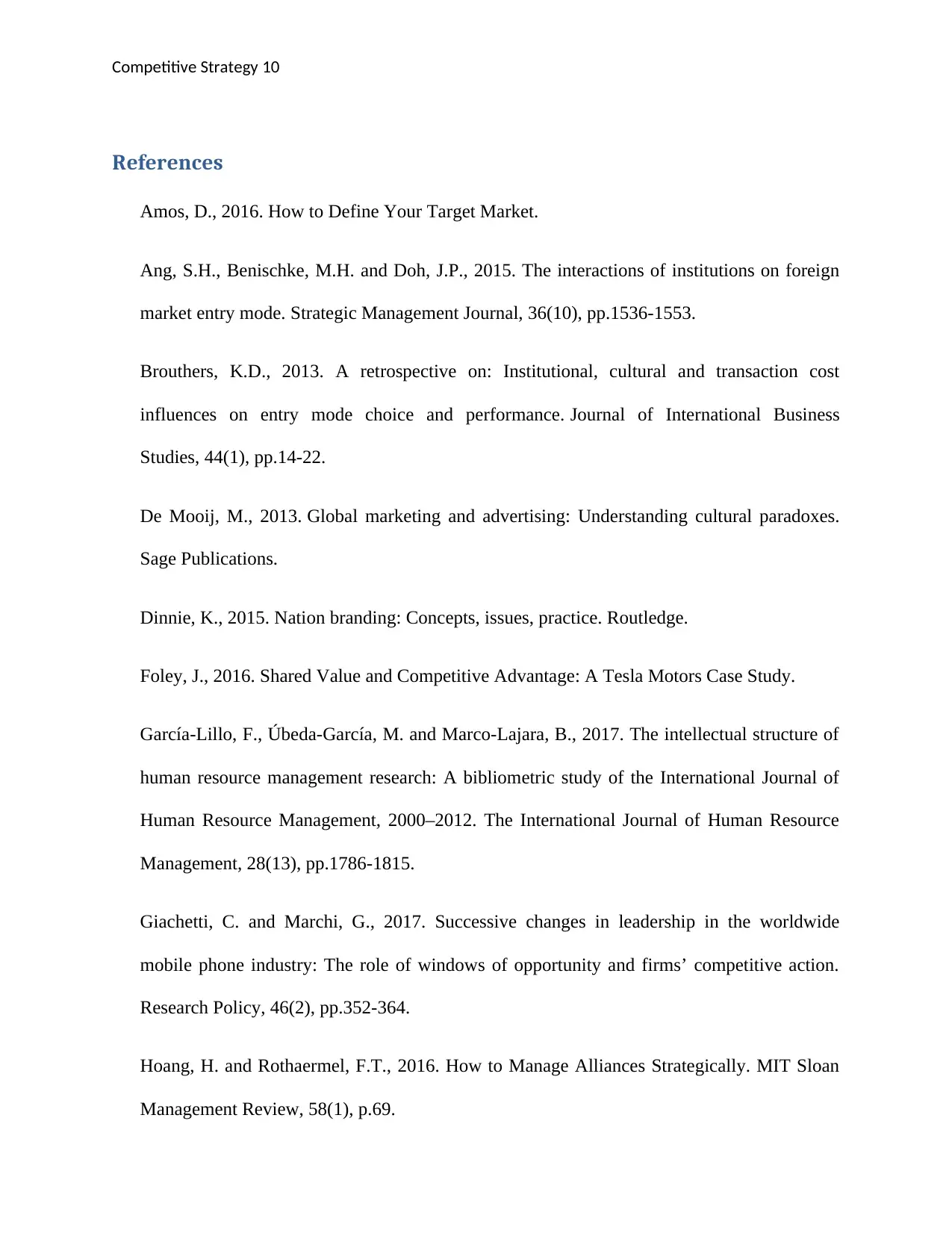
Competitive Strategy 10
References
Amos, D., 2016. How to Define Your Target Market.
Ang, S.H., Benischke, M.H. and Doh, J.P., 2015. The interactions of institutions on foreign
market entry mode. Strategic Management Journal, 36(10), pp.1536-1553.
Brouthers, K.D., 2013. A retrospective on: Institutional, cultural and transaction cost
influences on entry mode choice and performance. Journal of International Business
Studies, 44(1), pp.14-22.
De Mooij, M., 2013. Global marketing and advertising: Understanding cultural paradoxes.
Sage Publications.
Dinnie, K., 2015. Nation branding: Concepts, issues, practice. Routledge.
Foley, J., 2016. Shared Value and Competitive Advantage: A Tesla Motors Case Study.
García-Lillo, F., Úbeda-García, M. and Marco-Lajara, B., 2017. The intellectual structure of
human resource management research: A bibliometric study of the International Journal of
Human Resource Management, 2000–2012. The International Journal of Human Resource
Management, 28(13), pp.1786-1815.
Giachetti, C. and Marchi, G., 2017. Successive changes in leadership in the worldwide
mobile phone industry: The role of windows of opportunity and firms’ competitive action.
Research Policy, 46(2), pp.352-364.
Hoang, H. and Rothaermel, F.T., 2016. How to Manage Alliances Strategically. MIT Sloan
Management Review, 58(1), p.69.
References
Amos, D., 2016. How to Define Your Target Market.
Ang, S.H., Benischke, M.H. and Doh, J.P., 2015. The interactions of institutions on foreign
market entry mode. Strategic Management Journal, 36(10), pp.1536-1553.
Brouthers, K.D., 2013. A retrospective on: Institutional, cultural and transaction cost
influences on entry mode choice and performance. Journal of International Business
Studies, 44(1), pp.14-22.
De Mooij, M., 2013. Global marketing and advertising: Understanding cultural paradoxes.
Sage Publications.
Dinnie, K., 2015. Nation branding: Concepts, issues, practice. Routledge.
Foley, J., 2016. Shared Value and Competitive Advantage: A Tesla Motors Case Study.
García-Lillo, F., Úbeda-García, M. and Marco-Lajara, B., 2017. The intellectual structure of
human resource management research: A bibliometric study of the International Journal of
Human Resource Management, 2000–2012. The International Journal of Human Resource
Management, 28(13), pp.1786-1815.
Giachetti, C. and Marchi, G., 2017. Successive changes in leadership in the worldwide
mobile phone industry: The role of windows of opportunity and firms’ competitive action.
Research Policy, 46(2), pp.352-364.
Hoang, H. and Rothaermel, F.T., 2016. How to Manage Alliances Strategically. MIT Sloan
Management Review, 58(1), p.69.
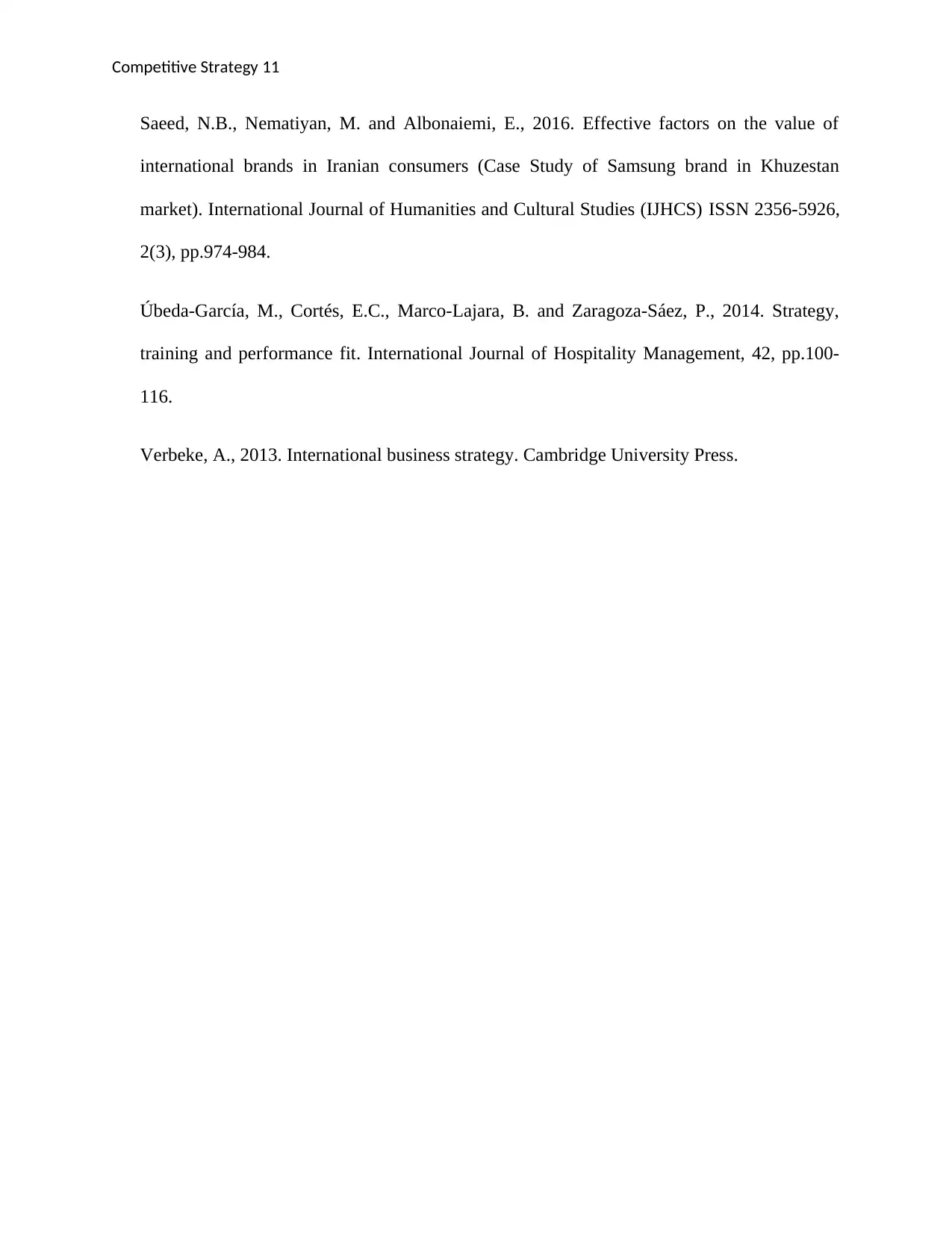
Competitive Strategy 11
Saeed, N.B., Nematiyan, M. and Albonaiemi, E., 2016. Effective factors on the value of
international brands in Iranian consumers (Case Study of Samsung brand in Khuzestan
market). International Journal of Humanities and Cultural Studies (IJHCS) ISSN 2356-5926,
2(3), pp.974-984.
Úbeda-García, M., Cortés, E.C., Marco-Lajara, B. and Zaragoza-Sáez, P., 2014. Strategy,
training and performance fit. International Journal of Hospitality Management, 42, pp.100-
116.
Verbeke, A., 2013. International business strategy. Cambridge University Press.
Saeed, N.B., Nematiyan, M. and Albonaiemi, E., 2016. Effective factors on the value of
international brands in Iranian consumers (Case Study of Samsung brand in Khuzestan
market). International Journal of Humanities and Cultural Studies (IJHCS) ISSN 2356-5926,
2(3), pp.974-984.
Úbeda-García, M., Cortés, E.C., Marco-Lajara, B. and Zaragoza-Sáez, P., 2014. Strategy,
training and performance fit. International Journal of Hospitality Management, 42, pp.100-
116.
Verbeke, A., 2013. International business strategy. Cambridge University Press.
⊘ This is a preview!⊘
Do you want full access?
Subscribe today to unlock all pages.

Trusted by 1+ million students worldwide
1 out of 12
Related Documents
Your All-in-One AI-Powered Toolkit for Academic Success.
+13062052269
info@desklib.com
Available 24*7 on WhatsApp / Email
![[object Object]](/_next/static/media/star-bottom.7253800d.svg)
Unlock your academic potential
Copyright © 2020–2025 A2Z Services. All Rights Reserved. Developed and managed by ZUCOL.





